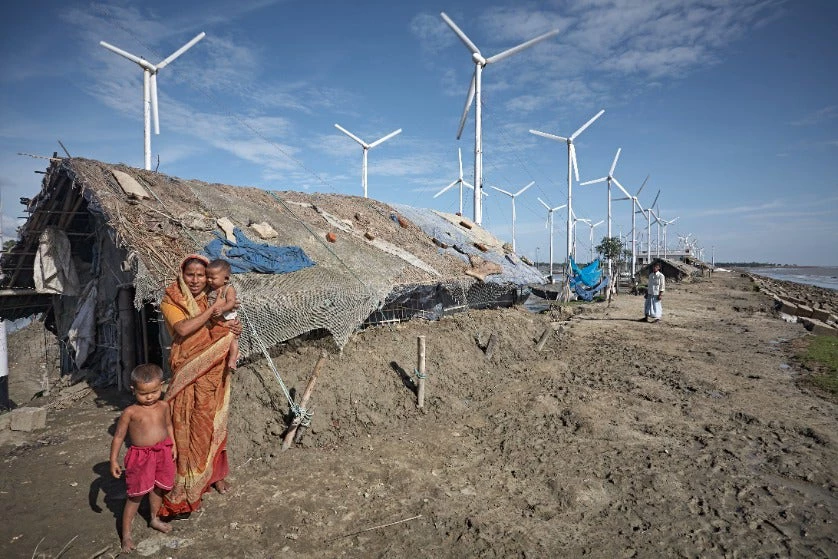
Eradicating extreme poverty and stopping global warming can only be tackled together: reducing poverty without considering carbon emissions is a self-defeating strategy, as climate change impacts will threaten hardly won development gains. But despite rapid progress to decarbonize the world economy, reducing poverty by increasing people’s consumption today requires increasing carbon emissions, since economic systems in most developing countries still rely on fossil fuel energy. And the eradication of extreme poverty is so urgent that it cannot be delayed, especially to fix a problem that has largely been created by the richest among us.
How to solve this quandary? And does this quandary really exist? Here we explore whether there is a trade-off between eradicating poverty and achieving a net zero emission target.
The good news is that eradicating extreme poverty would increase emissions by less than 5 percent and doing so can thus safely be considered an absolute priority, even if it is done with historical energy and carbon intensities. In contrast, providing middle-class standards of living to all while stabilizing climate change will require radical changes in energy and carbon intensity, and this is where the challenge lies for the next few decades.
Previous studies have primarily calculated the carbon emissions that would be generated by the consumption of today’s poor, if their consumption was increased to the consumption poverty line.[i] But this approach is too optimistic: more than 90 percent of poverty reduction comes from economic growth, which increases consumption across the income distribution, not only the consumption of the poor. A realistic path to eradicating extreme poverty would lead to higher emissions than just increasing the consumption of the people living in poverty.
In a recent study featured in the new 2023 SDG Atlas, we take economic growth as the driver of poverty alleviation and estimate the emissions associated with the economic growth needed to eradicate poverty. Our goal is not to predict future emissions but to explore a range of stylized scenarios based on the historical relationships between poverty reduction, economic growth, and the energy and carbon intensity of GDP, to identify the potential conflicts between our objectives.
First, we estimate the per capita GDP growth needed to reduce extreme poverty to 3% in all countries, the World Bank’s target global poverty rate. Assuming unchanged inequalities, the growth needed ranges from zero in high-income countries to more than 500% in South Sudan, Burundi, and Central African Republic.
Next, we identify the historical link between per capita GDP growth and greenhouse gas (GHG) emissions by relating GDP to energy consumption and then energy consumption to GHG emissions. Of course, the global decarbonization process will change these parameters in the future. We first assume that the historical rates of improvements in energy efficiency and carbon efficiency continue unchanged into the future.
Finally, we calculate the emissions associated with the GDP growth needed to end poverty. Compared with a scenario without any reduction in poverty, ending extreme poverty in all countries by 2050 with historical energy and carbon intensity patterns would increase annual emissions by only 2.37 gigatons of CO2e or 4.9% of 2019 global emissions.[ii] We were surprised by how small this increase is: it corresponds approximately to the increase in emissions the world has been experiencing every three years since 2000.
It means that eradicating extreme poverty can safely be considered an absolute priority: even if poverty reduction was done with historical energy and carbon intensity patterns, it would not threaten our global climate goals. For instance, global emissions would need to be reduced by 2.08 gigatons of CO2e per year instead of the 2.0 gigatons of CO2e per year to accommodate for increased emissions due to poverty eradication – a modest and achievable raising of ambitions. Non-poor countries could eliminate any tension between the two goals by marginally increasing their annual rate of decarbonization by 0.28 percent.
The reason there is so little tradeoff between climate goals and ending extreme poverty is because the extreme poverty line is very low and represents a very small increase in consumption relative to total global consumption. It reflects the abject nature of extreme poverty, underscoring that eradicating extreme poverty is an absolute urgency and priority.
The real tension between the nature of the development path and climate goals emerges at higher poverty lines. Bringing all people to higher consumption levels and decent living conditions would increase emissions much more, if done with historical patterns and rates of improvement in energy and carbon intensities. With the lower-middle-income poverty line of $3.65 per day, current trends would push the increase in annual emissions in 2050 to 7.4 gigatons or 15.3% of 2019 emissions. At the upper-middle-income poverty line of $6.85 per day, the added annual emissions in 2050 amount to 22.1 gigatons or 45.7% of 2019 emissions.
It means that eradicating poverty at middle-income poverty lines, which is needed to provide decent living conditions to the world population, while achieving our global climate goals will require to accelerate radically energy efficiency gains and the decarbonization of energy. Achieving these goals together is also easier if growth is more inclusive: if countries grow while reducing inequality at the rate of historical best performers, they can eradicate poverty with 65% less emissions than with current inequalities.
These results do not mean that countries have to choose between development and climate goals; it only means that future development pathways will have to be different than in the past to provide universal access to decent living conditions.
In fact, reconciling climate and development at all income levels may be easier than it seems.
First, in today’s world many of the best development interventions happen to also reduce carbon emissions, like replacing diesel generators by solar power in rural communities, developing utility-scale renewable energy instead of more expensive and polluting coal power plants, replacing imports of fossil fuels by locally produced renewable energy, using electricity or gas instead of charcoal for cooking, providing better public transit and infrastructure for non-motorized and electrified transport in cities, and using climate-smart agriculture practice to reduce deforestation and protect soils.
Growing evidence, including from our recent series of Country Climate and Development Reports, shows how a resilient and low-carbon development path can accelerate economic growth and deliver development benefits thanks to a more efficient use of resources, lower congestion and air pollution, and reduced energy imports.
Second, to make low-income countries’ development sustainable over the long-term, it should not lock them into dependency on outdated technologies and fossil fuels. Better for these countries to leapfrog directly to today’s best technologies, instead of investing first in dirtier options that will need to be replaced in only a few decades. We should not miss the short-run opportunities offered by green technologies just because poor countries do not need to reduce their emissions.
Our analysis does not provide definite answers but hopefully helps focus on what matters. There is no conflict between extreme poverty reduction and global emissions: eradicating extreme poverty is an absolute urgency and priority; even with today’s trend, doing it would add little emissions; and the poorest populations are the most vulnerable to climate change, and the first beneficiaries of green practices and technologies. But we cannot achieve more ambitious development objectives and provide all people with decent living conditions without a radical change in energy and carbon intensity. This is where the future will look radically different from the past.
[i] See for example Bruckner et al. (2022) and Hubacek et al. (2017). Malerba (2019) is closer to our approach though without invoking growth as the driver of emissions and poverty reduction.
[ii] The study focuses on energy-related emissions because the study finds no systematic link between economic growth and deforestation: while past economic growth has relied on more energy in all countries, it is not the case for deforestation.




Join the Conversation